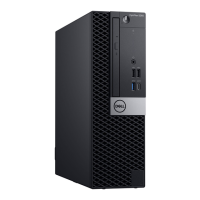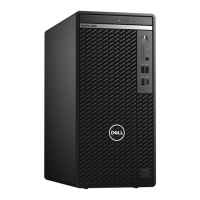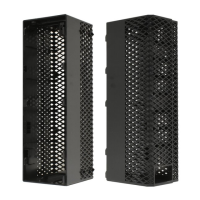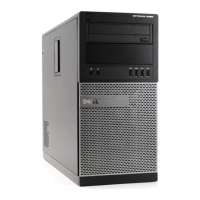8. Shut down the computer.
9. Press and hold the Fn key, while pressing the power button, and then release both.
10. Repeat steps 3–7 above.
Power-Supply Unit Built-in Self-Test
Built-in Self-Test (BIST) helps determine if the power-supply unit is working. To run self-test diagnostics on the power-supply
unit of a desktop or all-in-one computer, see the knowledge base article 000125179 at www.dell.com/support.
Diagnostics
The computer POST (Power On Self Test) ensures that it meets the basic computer requirements and the hardware is working
appropriately before the boot process begins. If the computer passes the POST, the computer continues to start in a normal
mode. However, if the computer fails the POST, the computer emits a series of LED codes during the start-up. The system LED
is integrated on the Power button.
The following table shows different light patterns and what they indicate.
Table 3. Power LED summary
Amber LED state White LED state System state Notes
Off Off S5
Off Blinking S3, no PWRGD_PS
Previous State Previous State S3, no PWRGD_PS This entry provides for
the possibility of a delay
from SLP_S3# active to
PWRGD_PS inactive.
Blinking Off S0, no PWRGD_PS
Steady Off S0, no PWRGD_PS, Code
fetch = 0
Off Steady S0, no PWRGD_PS, Code
fetch = 1
This indicates that the host
BIOS has started to execute
and the LED register is now
writable.
Table 4. Amber LED blinking failures
Amber LED state White LED state System state Notes
2 1 Bad MBD Bad MBD - Rows A, G, H, and
J from table 12.4 of SIO Spec
- Pre-Post indicators [40]
2 2 Bad MB, PSU or cabling Bad MBD, PSU or PSU
cabling - Rows B, C and D of
table 12.4 SIO spec [40]
2 3 Bad MBD, DIMMS, or CPU Bad MBD, DIMMS or CPU -
Rows F and K from table 12.4
of SIO spec [40]
2 4 Bad coin cell Bad coin cell - Row M of table
12.4 in SIO spec [40]
Troubleshooting 73
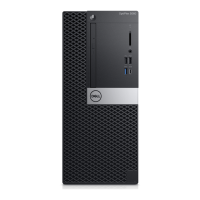
